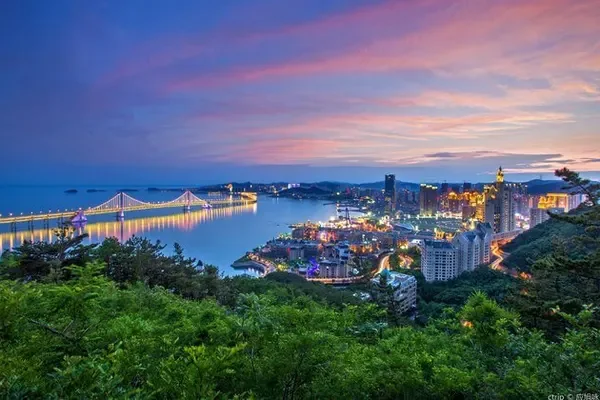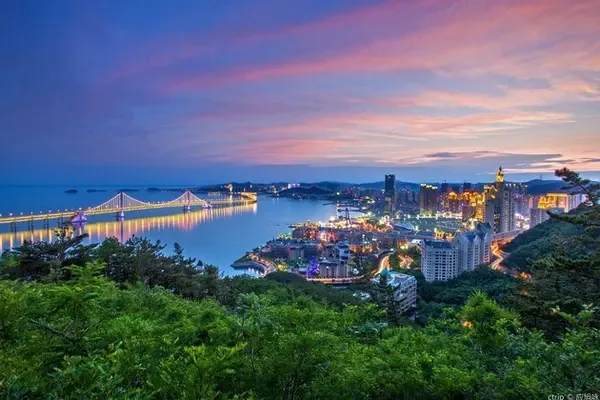Since Ruicheng, where Yongle Palace is located, is on the bank of the Yellow River, I walked towards the river and saw a famous ancient ferry, Fenglingdu. Now that the Fenglingdu Bridge has been built on the Yellow River, the natural moat has long since become a thoroughfare. Coupled with the construction of the Sanmenxia Reservoir, it is within the backwater range of the dam. Not only is the water surface wide, but it is also surging. The ancient ferry is no longer there, only the boatman stands sadly on the river beach.

The Yellow River turns from north to south and flows eastward at Ruicheng. The north bank is Ruicheng of Jin, and the south bank is Tongguan of Qin. I crossed the Yellow River from Fenglingdu to visit the famous Tongguan on the south bank. Fenglingdu is called Tongguan Ferry on the Qin side.

The site of Tongguan Ferry has been submerged underwater, and the government has built another house as Ferry Old Street.

Tongguan has been an important traffic route between the Central Plains and Guanzhong since ancient times, and it is a place where strongmen must contend. During the Spring and Autumn Period and the Warring States Period, the six countries other than Qin joined forces with the Lu Kingdom, and gathered millions of people to attack Qin. At that time, it was Hangu Pass, and the Qin army refused to join the allied forces outside Hangu Pass. At the end of the Eastern Han Dynasty, in order to strengthen the defense of the Central Plains to the west, Cao Cao extended the defense line of Hangu Pass westward to Tongguan, built a pass city, and fought against Ma Chao and Han Sui here. Tongguan was built by Cao Cao. Since then, the offensive and defensive positions in Guanzhong and the Central Plains have become Tongguan, and the Guanxi and Guandong said Guan has been changed from Hangu Pass to Tongguan. In fact, the distance between Hangu Pass and Tongguan is less than 100 kilometers. In addition to the two celebrities Cao Cao and Ma Chao who fought in Tongguan, the two big names Yu Wentai and Gao Huan in the late Northern Wei Dynasty also fought here. From the Sui Dynasty to the Tang Dynasty, the Tongguan castle was moved twice, and it was not far away. After the Song Dynasty, it has not changed.
When the Sanmenxia Reservoir was being built, the ancient city of Tongguan was expected to be flooded, so it was moved to a higher place as a whole. As a result, the water power was not enough, and the old city was not flooded, so some ruins were left for me to see.

And city bricks.

There are even horse tethering posts from the Tang Dynasty.

I asked where did Tongguan, a fellow on the roadside, move? The villagers point to the banners on the top of the mountain. I tried to go up again, passing a ruin, which was a bit scary.

Walking over to take a look, this is a combat readiness facility during the Republic of China.

Ming city ruins.

In recent years, large sums of money have been invested to build new buildings next to the ruins.

A new temple was also built to worship the gods.

Which god was sacrificed? It's Nuwa.

There are also chickens, ducks, dogs, rabbits, pigs, horses, cattle and sheep.

A building was built in imitation of the gate of Tongguan City, and it became a museum.

The exhibits inside are Qin bricks and Han tiles bought locally.


The museum also displays the deeds of several local celebrities. The following one is "Yang Zhen Mu Ye But Jin". Yang Zhen was a famous official in the Eastern Han Dynasty, a native of Tongguan, and a very clean and honest person. Once when he was promoted to the governor of a certain place, he passed by Changyi, and the county magistrate here was Wang Mi recommended by him. Wang Mi went to Changyi Hotel to visit Yang Zhen at night, and brought ten catties of gold with him. Of course, Yang Zhen couldn't accept gifts from others, because Yang Zhen was known as "Kanxi Confucius Yang Boqi". Wang Mi said to Yang Zhen, "It's so late, no one knows, so please accept it", Yang Zhen replied, "God knows, the earth knows, you know, I know, why no one knows", this is the eight-character motto of origin. Later, Wang Mi told everyone about it, and it became known to the world.

In the 14th year of Tianbao (755 A.D.) during the reign of Emperor Xuanzong of the Tang Dynasty, An Lushan rebelled in Fanyang. Luoyang was captured that year, and Tongguan was attacked the following year. Tongguan defender Ge Shuhan followed Tang Xuanzong's faint tricks to attack instead of retreating. As a result, he was surrounded by an ambush from Anlu Mountain, Ge Shuhan's 80,000 Tang troops were wiped out, he was captured, and Tongguan fell. After taking Tongguan, the Anlushan rebels directly threatened Chang'an, and Tang Xuanzong had no choice but to walk west to avoid it. The direct consequence of the fall of Tongguan was that the rebels then occupied Chang'an and broke through the second capital, which indirectly led to the death of Concubine Yang and the loss of Tang Xuanzong's throne. Three years later, the An Lushan rebellion was over. The poet Du Fu passed by Tongguan, and he was quite moved. He wrote "Tongguan Officials", in which there is a sentence "Please advise the defense generals, be careful not to learn from Brother Shu".

Neither in Du Fu's poems nor in the footnotes did he mention meeting the "Guardian of Defense", so there is the word "please". The wax figure above is purely out of the ordinary.
Tongguan is very famous, but now Tongguan is not what it looks like, unfortunately.


